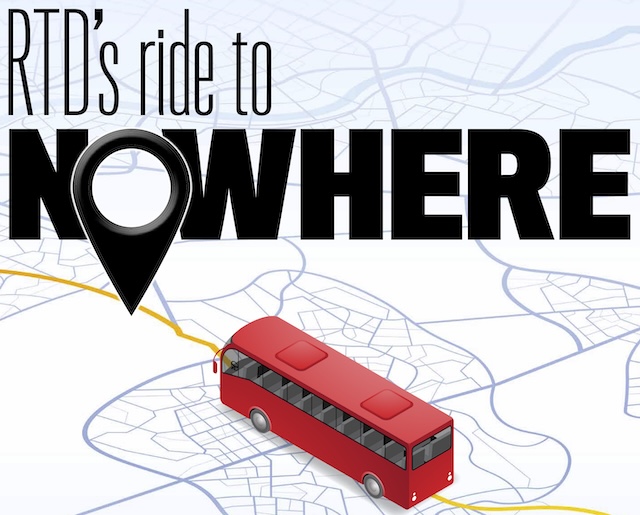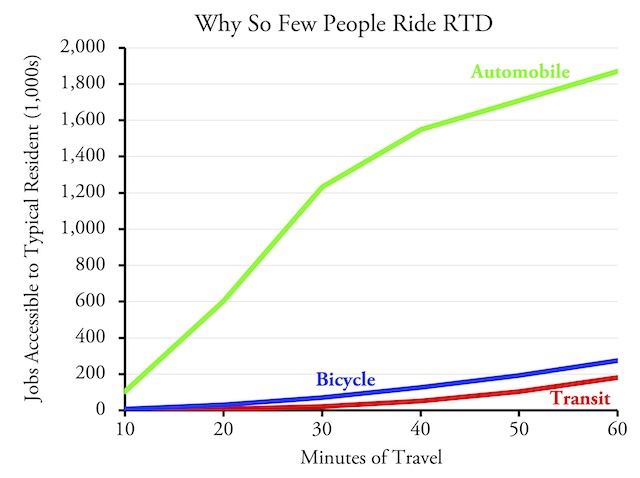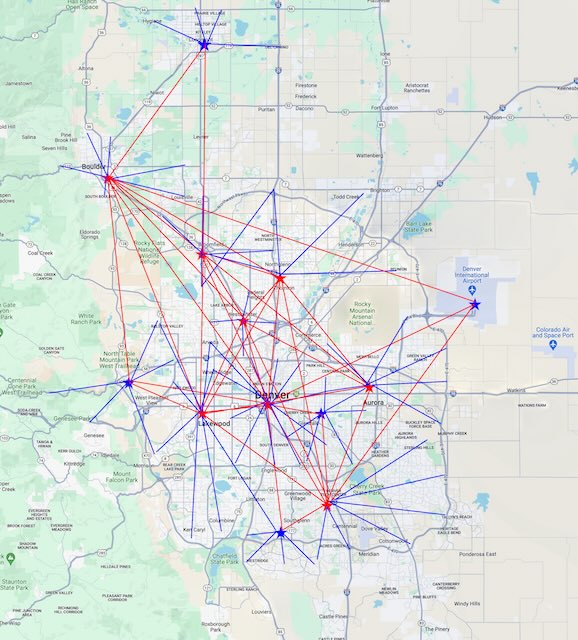Denver’s Regional Transit District (RTD) has been slower than average to recover from the pandemic, carrying only 59 percent of pre-pandemic riders in June compared with an industry-wide average of 75 percent. Key legislators want to fix this problem by reforming how the agency’s board of directors is selected. Instead of letting voters select board members, they want to have them appointed.
Click image to download a PDF of this commentary.
This is equivalent to rearranging the deck chairs when the ship is sinking, charged an opinion piece in yesterday’s Denver Gazette. The article points out that RTD’s real problem is its downtown-centric route map. Prior to the pandemic, transit carried 22 percent of downtown Denver employees to work but only 2.6 percent of workers in the rest of the urban area.
If this sounds familiar, it is because the commentary was written by the Antiplanner. The Gazette‘s editorial page editor, Dan Njegomir, invited me to write up to 2,000 words, which is unusually long for an op-ed, which most papers limit to 750 words or less. I made the most of it, submitting 1,980 words.
I also offered the Gazette two optional figures that they elected not to use. Though they aren’t essential to the article, I am including them here so that my effort won’t go completely to waste.
First is a chart based on the latest University of Minnesota Accessibility Observatory data showing that Denver transit accesses far fewer jobs than autos and even fewer than bicycling over all trip lengths from 10 minutes to 60 minutes. This, I explain in the article, is why so few Denver-area residents ride transit.
A transit plan for Denver: Red stars are primary transit centers, blue stars are secondary centers, red lines indicate non-stop bus routes, blue lines indicate local bus routes. Red and blue lines show origins and destinations, not detailed routes. Click image for a larger view.
Second was a map showing a proposed non-downtown-centric transit plan based on non-stop buses between major economic centers in the region with local buses radiating away from each center. This would give hundreds of thousands of commuters as good transit service as is now enjoyed by downtown workers. Antiplanner readers know that I’ve previously made similar maps for Calgary, Portland, San Jose, and St. Louis.
The article concludes by suggesting that Denver-area residents who want a better transit system that isn’t so downtown-centric should contact their elected representatives on the RTD board. Fortunately for them, RTD is one of the few transit agencies that has an elected board, which is a safeguard some members of the Colorado legislature want to take away.











Transit agencies embed themselves in the public consciousness by behaving as “ethical business”
They have boards of directors, CEO’s, presidents?
Why?
They are not a business, they don’t make a profit. Their financial assets should not be divided up among a dozen different management and bureaucracy titles.
Prior to the pandemic, transit carried 22 percent of downtown Denver employees to work but only 2.6 percent of workers in the rest of the urban area. ”
Urban planners and transit afficianados wanted a centrist business model for a model that wasn’t a business. Real businesses cut costs when revenue declines. Transit doesn’t do that. Remember this mindset.
During 2017 Obama era Shutdown; 400,000 non-essential workers were furloughed; for 2 weeks, they went without pay. They vowed This would never happen again…..
During Pandemic; Government workers got Full pay, benefit and bonus/stimulus checks.
Real solution here is dissolution board. RTD needs One manager and one vice, safety advisory inspector, construction/asset foreman, human resources director to oversee all it’s employees.
Of course What need in a deregulated transit market. Deregulated paratransit can move anyone cheaply. New Jersey is running adequate Jitney service little as a Dollar…….But Children can be accommodated effortlessly, by same transit system, parents maintain “netflix” style subscription and vanpool picks em up to take them to desired destinations, Parks, Malls. Anyone under 16 cant drive or own a vehicle.
Excellent column. This will have heads exploding in metro Denver, Colorado Springs, and Fort Collins:
Re: Cherry Creek, I don’t think they actually want more transit. Like many cities, transit carries crime to downtown Denver. High-end businesses are fleeing downtown and relocating to pricey Cherry Creek which has just one east-west and one north-south bus route running through the center; no light rail at all. It does have a popular and practical bike path on the southern edge.
Cherry Creek thriving while other commercial districts in U.S., including downtown Denver, are struggling
Office vacancy rate at 8.5% while downtown’s is at 23%
I spoke too soon:
Denver Metro Bus Rapid Transit (BRT) Project
Colorado Boulevard from I-70 to I-25 (6.5 miles) – Multimodal corridor study is underway
Increases the number of people who can travel on a road while using fewer vehicles, ultimately easing congestion and reducing greenhouse gas emissions
Colorado Blvd. borders Cherry Creek to the east.